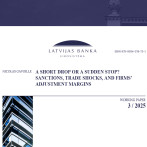After euro introduction, retail trade volumes in Latvia more stable than in Estonia
The first quarter data for 2014 published today indicate that the retail trade turnover in the first quarter grew 2.2% year-on-year (calendar adjusted data). Quarter-on-quarter, the retail trade turnover, according to seasonally adjusted data, slightly dropped (by 0.4%).
In the last quarter of 2013, the rise in sales volumes was primarily on account of the rise in the sales of foodstuffs (including non-foodstuffs in supermarkets), furniture and household goods, which was related to residents spending their lats accruals before the changeover to the euro.
After larger expenditures, a drop in the sales volumes of durable goods has followed in the first quarter of this year. Albeit there was a drop quarter-on-quarter, it was small compared to the developments seen in Estonia's retail trade at the beginning of the year of euro introduction.
As opposed to Estonia, where in the first months of euro adoption a rapid shrinking in the retail trade turnover was observed, in Latvia, the sales amounts and consumption levels were relatively stable. The main factor in trade and consumption stability could be the price trends favourable to consumers. In Estonia, the euro introduction process coincided with a more rapid rise in global prices: higher inflation expectations were observed, which might have stimulated prior purchases to a greater extent than in Latvia. Even though in Latvia the previously predicted euro impact on expenditure habits and trade structure was indeed observed, the drop in sales volumes at the beginning of the year was relatively small.
The relatively optimistic consumer confidence indicator at the end of 2013 likewise suggested a more stable consumption dynamic than in Estonia. After slightly deteriorating at the beginning of 2014, it once again improved rapidly, reaching the most positive evaluation since 2007. The Latvian total economic sentiment index in April grew by 0.9 points reaching 105.0, which is the eighth highest indicator in the European Union. Improvement in consumer confidence was the main driving force of the economic sentiment index. The evaluation of the financial situation and assessment of savings levels for the next 12 months have grown substantially, with unemployment expectations dropping at the same time. An improvement in the financial situation of consumers can have a direct and positive effect on improvement in retail trade.
Textual error
«… …»






